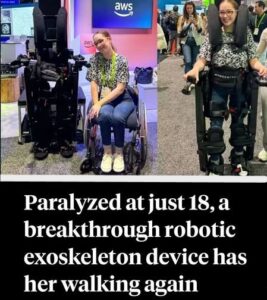Paralyzed at 18, she’s walking again thanks to a groundbreaking robotic exoskeleton

Caroline Laubach’s early adulthood was marked by more medical battles than most people face in a lifetime. By 22, she had survived heart failure, endured a spinal stroke that paralyzed her from the waist down, received a heart transplant, and beaten cancer twice. Simply being alive is remarkable on its own — but now, she’s doing something doctors once told her was impossible: she’s walking again.
Laubach was selected to test a revolutionary, self-balancing robotic exoskeleton created by the tech company Wandercraft. Once she straps into the prototype, the machine gives her the ability to stand up on her own, walk without assistance, bend to retrieve objects, chat with friends at eye level, and even climb stairs — all controlled through a small joystick mounted near her left hand.
A device that changed her world
“It’s a chance I truly didn’t believe I’d ever have again,” Laubach told ABC News.
Even before receiving the device, Laubach earned admiration from local leaders and fellow students for refusing to let paralysis limit her identity. As secretary of the Disabled Students Union at Cedar Crest College in Allentown, Pennsylvania, she became a source of inspiration — ultimately being named Survivor of the Year at the American Heart Association’s Heart Ball in Lehigh-Berks County.
Wandercraft, meanwhile, has spent years refining its technology with the goal of restoring mobility to those who’ve lost it. Since announcing its work in 2023, the company has advanced its Eve exoskeleton — the model now helping Laubach walk — while also developing rehabilitation-focused versions and heavy-duty robotic systems for strenuous physical labor.
Why don’t we see more of these devices available?
Despite exciting headlines about robotic exoskeletons, they’re still far from common. More than a dozen models have FDA approval, yet few are widely accessible. The biggest hurdle: cost.
The most advanced exoskeletons, similar to Wandercraft’s Eve, can run upward of $100,000. Lower-powered models might be closer to $40,000, and while Medicare has begun offering reimbursement for certain permanently disabled users, the expense remains steep for most families.
Power and safety are also major barriers. More capabilities require larger batteries, and engineers must consider what happens if the device fails, loses power, or if the user falls and needs to get up safely.
Because of these challenges, exoskeletons are still considered emerging technology. Companies continue to test and refine designs so they can eventually reduce costs, improve reliability, and create models tailored to different mobility levels.
A glimpse of what’s possible
For now, one life has already been transformed.
Caroline Laubach, once paralyzed without hope of walking again, is now moving freely — standing tall at a time when that once felt impossible. And her story fuels the belief that, with enough innovation, persistence, and advocacy, these life-changing devices could one day become accessible to anyone who needs them.